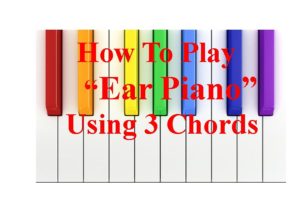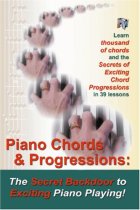How To Get Started Playing The Piano By Ear
“Ear Piano” – Two Things You Need To Know To Get Started
Good morning, this is Duane. Today I would like to talk about “ear piano“. People often ask me, “How can I get started? I just want to pick some things out on the piano. I just want to play piano by ear.” They ask me how to start getting started playing by ear. It’s really pretty simple because there’s only two things you really need to know. There’s a melody, that’s the tune of the song, and there’s the harmony, the chords that go in back of the song. If you match those two up, you can get started and make things sound pretty decent from within a few days or a few weeks.
Let’s take the first element, picking out the melody. Let’s say that you want to know how to play “Silent Night.” Well, you just pick a note, any note, I’ll pick a G, and then you use your memory to think how that song went. Now you may not do that first try, so you might go like this, but you can quickly tell that’s not right. It won’t take you too long to determine if those are the three notes you’re going to deal with. A melody can either stay the same or go up or go down. Those are the only three possibilities. There’s a limited number of options for you, but that’s good. That works in your favor.
You pick out the melody, and then the melody repeats, and that’s handy too because melodies often repeat. That’s the end of the first phrase. Next phrase is, no that’s not right; that’s right. Let’s take it that far, and then you pick out the…you see it doesn’t take much to figure out a melody, and that’s where I’d start, just with the melody.
Then there’s something you need to know about the harmony. In harmony, there’s three basic chords that help you harmonize melodies more than any other chords. If you know those three basic chords, you’ve gone a long ways towards harmonizing the melody. Those three chords are, they’re called the I-chord, the IV-chord, and the V-chord. Let me just show that in the key of C. The 1-chord is based on the first note of the scale, and every other note, so that’s a 1-chord. The 4-chord is the fourth note of the scale and you build a 4 there. The 5-chord is the fifth note of the scale and you build a chord there by playing every other note.
Now, what you do is you match the melody to the left hand harmony, so you might go; it doesn’t take long to figure out that’s wrong. Sounds better but that’s not right. Ah, that sounds right. You know the three chords that harmonize best with the 1, 4 and 5 chords, so when you get to the next phrase, that doesn’t sound right so try one of the other chords. Try the F chord, the 4-chord. That doesn’t sound right. How about the 5-chord? Ah, that sounds right, so let’s take it that far.
Then you pick out the next section, and you see that next note, it’s not in that chord, it’s not in the 1-chord, it’s not in the 5-chord, so try the 4-chord. I’m pushing down the damper pedal, the pedal on the right, to make things sounds a little smoother. We figured out “Silent Night” by just picking out the melody first and then matching one of those three chords to it.
Now, can you make it sound more advanced? Well, of course. You can break up the chord like that. You can use open voicing, which means playing the notes but separating them, the same notes of the chord, C, G, and E, but separating them. With the right hand, you can…you see that? I’m breaking up the G chord now, breaking up the C chord.
Now, in the right hand, you can harmonize the right hand too, couldn’t you? You could take some of the notes out of the left hand chord and put them in the right hand. Example: that’s called parallel thirds. Those notes are three notes apart, 1, 2, 3, 1, 2, 3, see that? Then after awhile, what you can do is add an echo. Listen. Echo. Echo, and on like that.
That’s how you get started playing piano by ear. The first step is to pick out the melody of whatever song you want to play. The next thing is to match the chords to that right hand melody, and you do that by looking for the 1, 4, and 5 chord of the key that you’re playing in. I don’t have time to talk about keys but that’s the basic strokes of learning to play piano by ear.
I hope that helps a little bit. Tune in again tomorrow as we take up another full subject like that. We’ll see then. Bye-bye for now.
Click on this link to watch this video on YouTube: https://www.youtube.com/watch?v=SnwNRQ5yOAg&feature=youtu.be
***For lots more good stuff on piano playing come on over to my website at https://www.playpiano.com and sign up for our free piano tips – “Exciting Piano Chords & Sizzling Chord Progressions!”
Here’s a great little book on chords and chord progressions on Amazon: http://www.amazon.com/Piano-Chords-Chord-Progressions-Exciting-ebook/dp/B0076OUGDE/ref=sr_1_1?s=books&ie=UTF8&qid=1404158669&sr=1-1&keywords=piano+chords+duane+shinn





